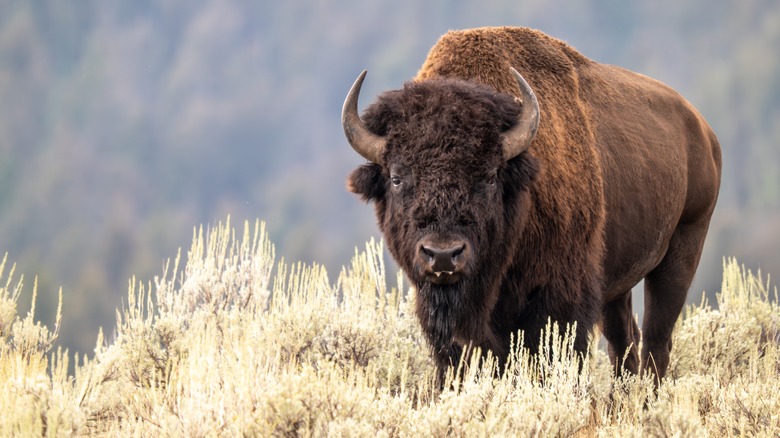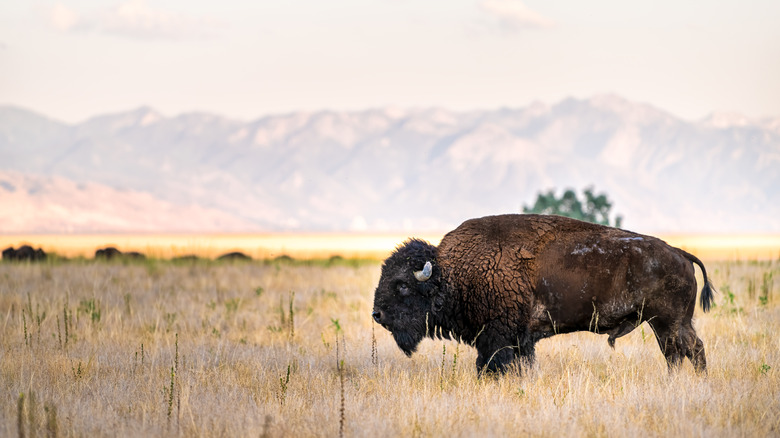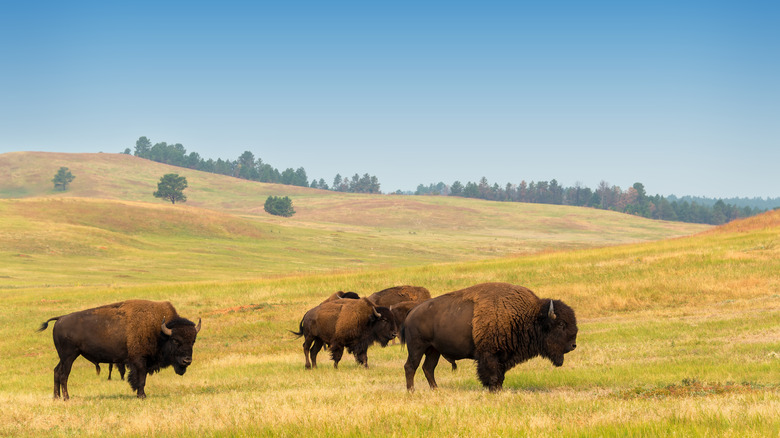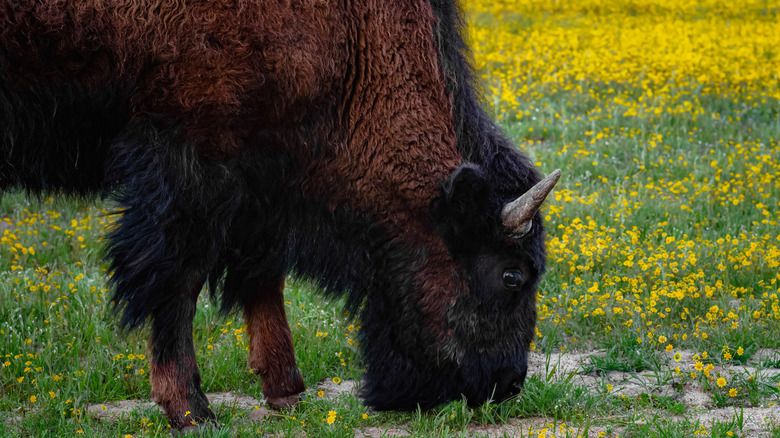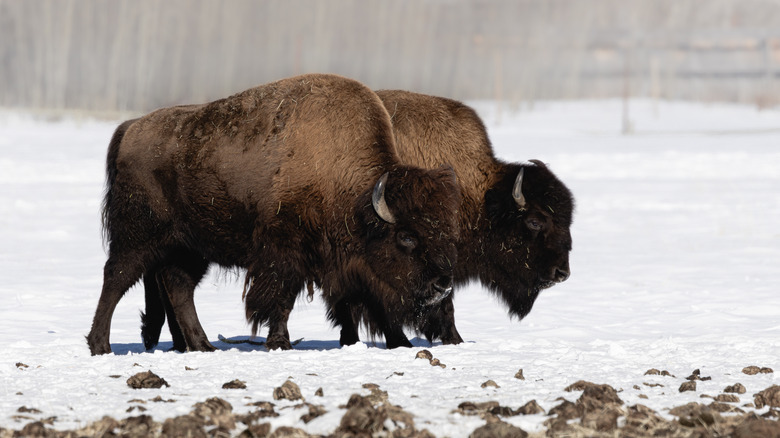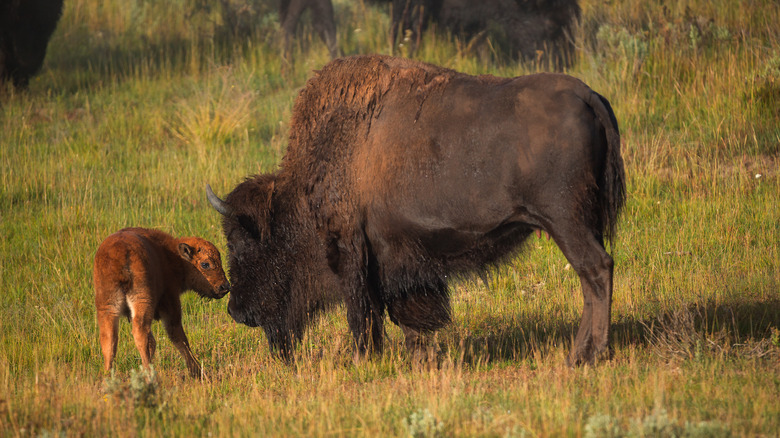The 5 Best Parks Outside Of Yellowstone Where You'll Find Beautiful, Wild Bison
It must have been quite something to witness the sight of 60 million bison as they thundered across the Great Plains in the 1800s. Once close to extinction, North America's largest land animal has bounced back thanks to successful conservation efforts. These not-so-gentle giants can weigh up to 2,000 pounds and, despite their docile appearance, can be unpredictable and potentially dangerous if they feel threatened.
The bison in Yellowstone National Park are particularly special. Not only is it the largest bison population in the U.S., but Yellowstone is also the only place where they've roamed since prehistoric times. But because Yellowstone is on everyone's bucket list, it also means jostling with crowds over the best viewpoints. And with more than 5,000 bison roaming the valleys (and sometimes crossing roads), it's not unusual to find yourself stuck in a "bison jam" as the animals like to take their time.
Five of the best places outside Yellowstone where you stand a great chance of seeing bison in the wild are Custer State Park and Badlands National Park in South Dakota, Antelope Island State Park in Utah, Elk Island National Park, and Wood Buffalo National Park in Canada. You'll find them amongst grasslands and prairie, where they spend their days grazing on grasses and sedges with only wolves and grizzlies to worry about as a potential threat.
Antelope Island State Park, Utah
Out on Great Salt Lake, just 42 miles from Salt Lake City in Utah, sits Antelope Island State Park, home to one of the largest herds of free-roaming bison in the U.S. The 28,000-acre island, accessible by a causeway, has between 500 and 700 bison at any one time. Just 12 bison were introduced to the island in 1893, and now the park is one of the best places to see bison in the wild, along with bobcats, coyotes, bighorn sheep, mule deer, and antelope, or pronghorn, the fastest land animals in North America. It's also a great place for birdwatching with over 250 species of birds, including owls, hawks, and falcons.
You can often see the bison from the park's roads and trails. The 15 hiking trails are scattered across the island, with some easy walks to more challenging hikes. For cyclists, the 44-mile out-and-back Antelope Island Causeway and South Island Trail starting in Syracuse crosses the causeway and continues south. The best time to see the herd is during the annual Bison Roundup, when rangers and volunteers herd the bison up for health checks and vaccinations. If you want to take part, it takes place in October and costs $70, or you can sit in comfort and watch from the side.
Custer State Park, South Dakota
On the southwestern side of Black Hills National Forest in South Dakota, Custer State Park is a 28-mile drive from Rapid City and around 15 minutes from Crazy Horse Memorial. Around 1,400 bison roam the 71,000-acre park, making them hard to miss. Your best chance of seeing them is along the Wildlife Loop Scenic Byway, an 18-mile loop that winds through open prairie, wildflower meadows, and granite peaks. You can drive it yourself in around two hours, or book a guided jeep tour to see bison and some of the other wildlife in the park, such as antelope, mule deer, and burros. The route starts from the visitor center on the park's northeast side.
If you prefer exploring on foot or horseback, there are a number of trails for hiking, biking, and riding. Guided trail rides are a peaceful way to see the park, and there are guided wildlife activities throughout the year. In September, the park organizes a Buffalo Roundup as part of the Buffalo Roundup Arts Festival, but you should book well in advance. A stop at the Custer State Park Bison Center will give you more information on the history and importance of bison. Entry to the park costs $25 per vehicle, and the visitor center is open all year round.
Badlands National Park, South Dakota
Further east from Custer State Park, Badlands National Park, also in South Dakota, protects one of the world's richest fossil beds and is home to around 1,200 bison. About an hour's drive west from Rapid City, this herd is one of the largest federal bison herds in the U.S. They were relocated here in 1963 from Theodore Roosevelt National Park. The best place to see them is at Sage Creek Rim Road, a 12-mile gravel road off the Badlands Loop State Scenic Byway. There's a small campground at the end of this road if you feel like waking up with bison nearby. You can also see them around the Deer Haven Trail or near the Pinnacles Entrance Station.
The seasons bring changes in the bison's behaviour. In Spring, they wallow in mud to have a good scratch and shed their winter coats, which keep them warm in the harsh winter months. Their coats are so thick that even when it snows, it never touches their skin. Badlands is one of the best places to see wildlife, with endangered species such as black footed ferrets, as well as bighorn sheep, prairie dogs, prairie rattlesnakes, and a variety of birds.
Wood Buffalo National Park, Canada
While herds in the U.S. are mainly plains bison, in Canada, you'll find both plains and wood bison. Wood Buffalo National Park is home to the largest free-roaming, self-regulating herd of wood bison, where they co-exist with their only natural predator, the wolf. Around 3,000 wood bison live in the immense 17,300 square miles of the park. Wood bison are adapted to colder climates than their plains relatives and are also slightly larger with longer legs and a darker coat. One easy way to tell them apart is by their hair. Plains bison have a bushy "hairstyle" and long beards, whereas wood bison have hair that flops over their forehead and shorter beards.
Classified as a threatened species, they can be found throughout the park and often graze along the roadside where the grasses thrive. You can often see them on Pine Lake Road, the main road into the park from Fort Smith. If you carry on up to Pine Lake, there's a great base for water-based activities like swimming, kayaking, and paddleboarding. The park's visitor center is based in Fort Smith, which sits on the southeast edge of the park and serves as the main gateway.
Elk Island National Park, Canada
About 29 miles east of Edmonton, Elk Island National Park is a UNESCO-designated biosphere reserve, with around 50 miles of trails and plenty of places to see bison as well as elk, moose, and white-tailed deer. The best place to see bison is on the aptly named Wood Bison Trail, a 9.6-mile loop starting at the park's south entrance off the Yellowhead Highway. The trail passes through Aspen forest and open plains over a series of boardwalks and passes by Flyingshot Lake, an ideal spot for birdwatching. This moderately challenging trail takes about four hours to complete but should reward you with sightings of either the park's 400 plains bison or 300 wood bison, as Elk Island is home to both.
For a chance to spot some baby bison calves, plan your visit for June. Familiarise yourself with what to do if you encounter a bison. Park rangers advise you to be especially careful around mothers with young, keep your distance, and look for warning signs such as snorting or pawing the ground. At around 75 square miles, Elk Island may be small compared to Canada's other national parks, but there's plenty going on. Head out on some of the other trails, or spend time at one of the many lakes. It's also a great place to spend the night, where the dark skies are perfect for stargazing, watching meteor showers, or catching a glimpse of the northern lights.
